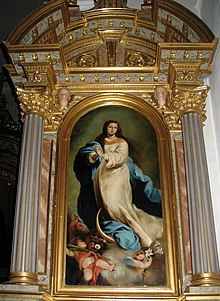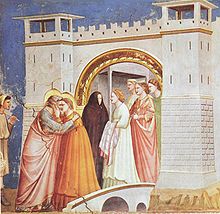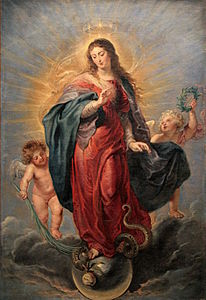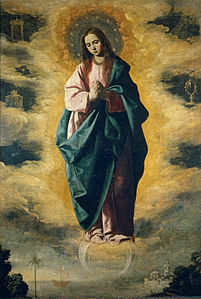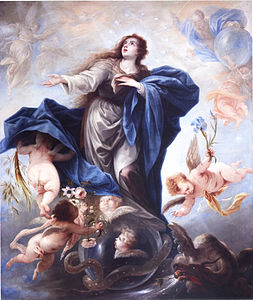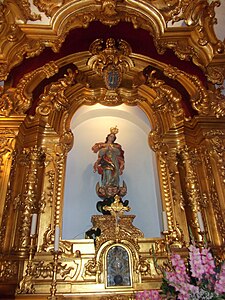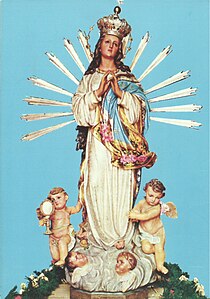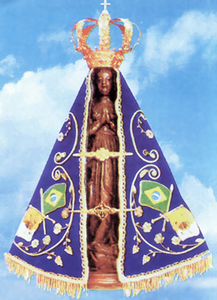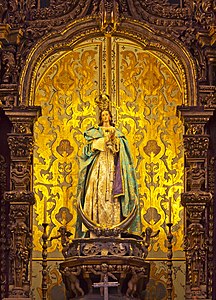Immaculate Conception
Immaculate Conception of Mary | |
|---|---|
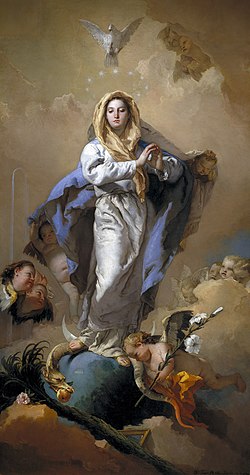 | |
| Major shrine | Basilica of the National Shrine of the Immaculate Conception |
| Feast | December 8 (Roman Rite) December 9 (Byzantine Rite) |
| Attributes | Crescent Moon Halo of Twelve Stars Blue Robe Putti Serpent Underfoot Assumption into Heaven |
| Patronage | |
The Immaculate Conception is a dogma of the Roman Catholic Church which states that the Virgin Mary was free of original sin from the moment of her conception.[1][Notes 1] It proved highly controversial in the Middle Ages, but revived in the 19th century and was adopted as church dogma when Pope Pius IX promulgated Ineffabilis Deus in 1854.[2][3] The move had the overwhelming support of the church's hierarchy, although a few, including the Archbishop of Paris, warned that it is not stated in the New Testament and could not be deduced from it.[4] Protestants overwhelmingly rejected Ineffabilis Deus as an exercise in papal power and the doctrine itself as without foundation in Scripture,[5] and Orthodox Christianity, although it reveres Mary in its liturgy, called on the Roman church to return to the faith of the early centuries.[6] The iconography of the Virgin of the Immaculate Conception shows her standing, with arms outspread or hands clasped in prayer, and her feast day is 8 December.[7]
The Immaculate Conception of Mary in the womb of her mother is not to be confused with her purity in the virgin birth of Jesus.[8]
Doctrine[edit]
The Immaculate Conception of Mary is one of the four Marian dogmas of the Catholic Church, meaning that it is held to be a truth divinely revealed, the denial of which is heresy.[9] Defined by Pope Pius IX in 1854, it states that Mary, through God's grace, was conceived free from the stain of original sin of her role as the Mother of God::[10]
We declare, pronounce, and define that the doctrine which holds that the most Blessed Virgin Mary, in the first instance of her conception, by a singular grace and privilege granted by Almighty God, in view of the merits of Jesus Christ, the Saviour of the human race, was preserved free from all stain of original sin, is a doctrine revealed by God and therefore to be believed firmly and constantly by all the faithful.[11]
(Since the 19th century a dogma has come to bear the meaning of a divinely revealed truth proclaimed by Church teaching and hence binding for all time on the faithful;[12] while the Immaculate Conception asserts only Mary's freedom from original sin, the Council of Trent, held between 1545 and 1563, affirmed in addition her freedom from personal sin.)[13]
History[edit]
Anna, mother of Mary[edit]
The mother of Mary is not a biblical character.[14] She first appears in the late 2nd-century Protevangelium of James, which names her Anne, probably from Hannah, the mother of the prophet Samuel; she and her husband, Saint Joachim, are infertile, but God hears their prayers for a child, and so Mary is conceived and born, and, like Samuel, is taken to spend her childhood in the temple.[15] In the earliest texts, probably representing the original version, the conception occurs without sexual intercourse between Anne and Joachim, but the story does not advance the idea of an immaculate conception.[16]
Original sin[edit]
Original sin, in Christian doctrine, is the condition or state of sin into which each human being is born; also, the origin (i.e., the cause, or source) of this state. Traditionally, the origin has been ascribed to the sin of the first man, Adam, who disobeyed God in eating the forbidden fruit (of knowledge of good and evil) and, in consequence, transmitted his sin and guilt by heredity to his descendants.[17] The doctrine was defined by Augustine of Hippo (354-430 AD).[18] Engaged in a controversy with the monk Pelagius over the question of whether infants could sin (Pelagius said they could not and therefore would not go to hell if unbaptised), he inserted original sin and the fall from grace into the story of the Garden of Eden and Paul's Letter to the Romans.[19] Augustine identified male semen as the means by which original sin was made heritable, leaving only Jesus Christ, conceived without semen, free of the sin passed down from Adam through the sexual act.[20]
Medieval formulation[edit]
Mary's freedom from personal sin was affirmed in the 4th century, but Augustine's argument that original sin was transmitted through sex raised the question of whether she could also be free of the sin of Adam.[10] The English ecclesiastic and scholar Eadmer (c.1060-c.1126) reasoned that it was possible in view of God's omnipotence and appropriate in view of Mary's role as Mother of God: Potuit, decuit, fecit, "it was possible, it was fitting, therefore it was done;"[21] Bernard of Clairvaux (1090-1153) and Thomas Aquinas (1225-1274), among others, objected that if Mary were free of original sin at her conception then she would have no need of redemption, making Christ superfluous; they were answered by Duns Scotus (1264-1308), who reasoned that her preservation from original sin was a redemption more perfect than that granted through Christ.[22]
Nevertheless, it was not theological theory that initiated discussion of Mary's freedom from mankind's curse, but the celebration of her liturgy: in the eleventh century the celebration of her liturgy, for the popular feast of her conception brought forth the objection that as normal human conception is sinful, to celebrate Mary's conception was to celebrate a sinful event.[23] Some held that no sin had occurred, for Anne had conceived Mary not through sex but by kissing her husband Joachim, and that Anne's father and mother had likewise been conceived, but St Bridget of Sweden (c.1303-1373) told how Mary herself had revealed to her in a vision that although Anne and Joachim conceived their daughter through sexual union, the act was sinless because free of sexual desire.[24]
In 1431 the Council of Basel declared Mary's immaculate conception a "pious opinion" consistent with faith and Scripture; the Council of Trent, held in several sessions in the early 1500s, made no explicit declaration on the subject but exempted her from the universality of original sin; and by 1571 the Pope's Breviary (prayerbook) set out an elaborate celebration of the Feast of the Immaculate Conception on 8 December.[25]
Ineffabilis Deus[edit]
It was popular support which led to the demand that the papacy elevate the doctrine to the status of dogma.[26] In 1830 Catherine Labouré (May 2, 1806-December 31, 1876) was granted a vision of Mary as the Immaculate Conception standing on a globe while a voice commanded Catherine to have a medal made in imitation of what she saw,[27] and the apparition marked the beginning of a great 19th-century Marian revival.[28] At the time the church was engaged in a struggle against modernity and the promotion of its authority,[29] and in 1849 Pope Pius IX asked the bishops of the church for their views on whether the doctrine should be defined as dogma: ninety percent of those who responded were supportive, and in 1854 the papal bull Ineffabilis Deus was promulgated.[2]
Ineffabilis Deus was one of the pivotal events of the papacy of Pius, pope from 16 June 1846 to his death on 7 February 1878.[3] Up until this point it had been understood that dogma had to be based in Scripture and accepted by tradition,[30] but Mary's immaculate conception is not stated in the New Testament and cannot be deduced from it,[4] and it had caused a virtual civil war between Franciscans and Dominicans during the middle ages.[31] Ineffabilis Deus therefore was a novelty, being based instead on the declaration of a special commission to the effect that neither scripture nor tradition were necessary to define dogma, but only the authority of the church expressed in the Pope.[30] The Pope and his curia (the special body which forms the central government of the church) accordingly waived the absence of scriptural proof or a "broad and ancient" stream of tradition and promulgated Mary's immaculate conception solely on papal infallibility,[32] itself promulgated as dogma in 1870.[33] (Some catholics unable to accept papal infallibility left the Roman Church and formed the Old Catholic Church, which rejects also the Immaculate Conception).[33][34] Four years later, Mary reputedly appeared to the young Bernadette Soubirous at Loudes in southern France, to announce that she was the Immaculate Conception.[35]
The Archbishop of Paris had warned Pius that the Immaculate Conception "could be proved neither from the Scriptures nor from tradition,"[36] but Ineffabilis Deus found it in the Ark of Salvation (Noah's Ark), Jacob's Ladder, the Burning Bush at Sinai, the Enclosed Garden from the Song of Songs, and many more.[37] From this wealth of support the pope's advisors singled out Genesis 3:15 as the basis for the Immaculate Conception: "The most glorious Virgin ... was foretold by God when he said to the serpent: 'I will put enmity between you and the woman,'"[38] a prophecy which reached fulfillment in the figure of the Woman in the Revelation of John, crowned with stars and trampling the Dragon underfoot.[39] Luke 1:28, and specifically the phrase "full of grace" by which Gabriel greeted Mary, was another reference to her immaculate conception: "she was never subject to the curse and was, together with her Son, the only partaker of perpetual benediction."[40]
Feast and patronages[edit]
The feast day of the Immaculate Conception is December 8.[7] Its celebration seems to have begun in the Eastern church in the 7th century and may have spread to Ireland by the 8th, although the earliest well-attested record in the Western church is from England early in the 11th.[41] It was suppressed there after the Norman Conquest (1066), and the first thorough exposition of the doctrine was a response to this suppression.[41] It continued to spread despite strong theological objections[42] (in 1125 St Bernard of Clairvaux wrote to Lyons Cathedral to express his surprise and concern that it had recently begun to be observed there),[23] but in 1477 Sixtus IV, a Franciscan, placed it on the Roman calendar (i.e, list of Church festivals and observances).[43] Pius V suppressed the word "immaculate",[44] but following the promulgation of Ineffabilis Deus it was restored with the typically Franciscan phrase "immaculate conception" and given a formulary for the Mass, drawn largely from one composed for Sixtus IV, beginning "O God who by the Immaculate Conception of the Virgin...". [45]
By pontifical decree a number of countries are considered to be under the patronage of the Immaculate Conception. These include Argentina, Brazil, Korea, Nicaragua, Paraguay, the Philippines, Spain (including the old kingdoms and the present state), the United States and Uruguay. By royal decree under the House of Bragança, she is the principal Patroness of Portugal.
Prayers and hymns[edit]
The Roman Missal and the Roman Rite Liturgy of the Hours naturally includes references to Mary's immaculate conception in the feast of the Immaculate Conception. An example is the antiphon that begins: "Tota pulchra es, Maria, et macula originalis non est in te" ("You are all beautiful, Mary, and the original stain [of sin] is not in you." It continues: "Your clothing is white as snow, and your face is like the sun. You are all beautiful, Mary, and the original stain [of sin] is not in you. You are the glory of Jerusalem, you are the joy of Israel, you give honour to our people. You are all beautiful, Mary.")[46] On the basis of the original Gregorian chant music,[47] polyphonic settings have been composed by Anton Bruckner,[48] Pablo Casals, Maurice Duruflé,[49] Grzegorz Gerwazy Gorczycki,[50] no:Ola Gjeilo,[51] José Maurício Nunes Garcia,[52] and Nikolaus Schapfl.[53]
Other prayers honouring Mary's immaculate conception are in use outside the formal liturgy. The Immaculata prayer, composed by Saint Maximillian Kolbe, is a prayer of entrustment to Mary as the Immaculata.[54] A novena of prayers, with a specific prayer for each of the nine days has been composed under the title of the Immaculate Conception Novena.[55]
Ave Maris Stella is the vesper hymn of the feast of the Immaculate Conception.[56] The hymn Immaculate Mary, addressed to Mary as the Immaculately Conceived One, is closely associated with Lourdes.[57]
Artistic representation[edit]
The Immaculate Conception became a popular subject in literature,[58] but its abstract nature meant it was late in appearing as a subject in art.[59] During the Medieval period it was depicted as "Joachim and Anne Meeting at the Golden Gate", meaning Mary's conception through the chaste kiss of her parents at the Golden Gate in Jerusalem;[60] the 14th and 15th centuries were the heyday for this scene, after which it was gradually replaced by more allegorical depictions featuring an adult Mary.[61] The 1476 extension of the feast of the Immaculate Conception to the entire Latin Church reduced the likelihood of controversy for the artist or patron in depicting an image, so that emblems depicting The Immaculate Conception began to appear. Many artists in the 15th century faced the problem of how to depict an abstract idea such as the Immaculate Conception, and the problem was not fully solved for 150 years. The Italian Renaissance artist Piero di Cosimo was among those artists who tried new solutions, but none of these became generally adopted so that the subject matter would be immediately recognisable to the faithful.
The definitive iconography for the depiction of "Our Lady" seems to have been finally established by the painter and theorist Francisco Pacheco in his "El arte de la pintura" of 1649: a beautiful young girl of 12 or 13, wearing a white tunic and blue mantle, rays of light emanating from her head ringed by twelve stars and crowned by an imperial crown, the sun behind her and the moon beneath her feet.[62] Pacheco's iconography influenced other Spanish artists or artists active in Spain such as El Greco, Bartolomé Murillo, Diego Velázquez, and Francisco Zurbarán, who each produced a number of artistic masterpieces based on the use of these same symbols.[63] The popularity of this particular representation of The Immaculate Conception spread across the rest of Europe, and has since remained the best known artistic depiction of the concept: in a heavenly realm, moments after her creation, the spirit of Mary (in the form of a young woman) looks up in awe at (or bows her head to) God. The moon is under her feet and a halo of twelve stars surround her head, possibly a reference to "a woman clothed with the sun" from Revelation 12:1–2. Additional imagery may include clouds, a golden light, and putti. In some paintings the putti are holding lilies and roses, flowers often associated with Mary.[64]
Piero di Cosimo, Immaculate Conception, 1505
El Greco, The Immaculate Conception with St John the Evangelist, c. 1585
Rubens, Immaculate Conception, 1628–1629
Zurbarán, Immaculate Conception, 1630
Murillo, Immaculate Conception, 1650
Murillo, Immaculate Conception, 1660
Murillo, Immaculate Conception, 1678
Carlo Maratta, 1689
Juan Antonio Escalante, 17th century
Caxias do Sul museum, Brazil
Statue, Porto Alegre, Brazil, 19th century
Palmi, Immaculate Conception, 1925
Nicaragua, Immaculate Conception, 1950
Our Lady of Aparecida, Brasilia
The Immaculate Conception, Church of the Immaculate Conception in Santa Cruz de Tenerife (Spain).
A bronze statue of the Immaculate Conception at the Manila Cathedral in Intramuros, Manila, Philippines
Other churches[edit]
Eastern Orthodoxy[edit]
Eastern Orthodoxy never accepted Augustine's ideas on original sin, and in consequence did not become involved in the later developments that took place in the Roman Catholic Church, including the Immaculate Conception. [65][66] When in 1894 Pope Leo XIII addressed the Eastern church in his encyclical Praeclara gratulationis, Ecumenical Patriarch Anthimos replied with an encyclical of his own in which he stigmatised the dogmas of the Immaculate Conception and papal infallibility as "Roman novelties" and called on the Roman church to return to the faith of the early centuries.[6] The Eastern Orthodox liturgy reveres Mary as Mother of God, "immaculate, spotless, and altogether without stain", so that as one contemporary Orthodox bishop puts it, "the Latin dogma seems to us not so much erroneous as superfluous."[67]
Protestantism[edit]
Protestants overwhelmingly condemned the promulgation of Ineffabilis Deus as an exercise in papal power, and the doctrine itself as without foundation in Scripture,[5] for it denied that all had sinned and rested on a translation of Luke 1:28 (the "full of grace" passage) that the original Greek did not support.[68] With the exception of some Lutherans and Anglicans, most Protestants therefore teach that Mary was a sinner saved through grace like all believers.[40]
Lutheranism[edit]
Martin Luther showed an abiding devotion to Mary, including her sinlessness and sanctity, and Lutherans hold Mary in high esteem,[69] but the Immaculate Conception does not hold the status of a dogma within Lutheranism.[70] The ecumenical Lutheran-Catholic Statement on Saints, Mary, issued in 1990 after seven years of study and discussion, affirmed "that the Catholic teaching about the saints and Mary as set forth in the documents of Vatican II does not promote idolatrous belief or practice and is not opposed to the gospel," but conceded that Lutherans and Catholics remained separated "by differing views on matters such as the invocation of saints, the Immaculate Conception and the Assumption of Mary."[71]
Anglican Communion[edit]
December 8 is designated a lesser festival of the Conception of the Blessed Virgin Mary (without the adjective "immaculate") in the Church of England's Book of Common Prayer but although some Anglicans may hold the Immaculate Conception as an optional pious belief, the final report of the Anglican–Roman Catholic International Commission (ARCIC), created in 1969 to further ecumenical progress between the Roman Catholic Church and the Anglican Communion, recorded the disagreement of the Anglicans with the doctrine.[72]
Islam[edit]
A saying of Mohammad recorded in the 9th century by the Muslim scholar Muhammad al-Bukhari quotes the Prophet saying that Satan touches all the descendants of Adam "except Mary and her child"; medieval Christian monks later used this passage to claim that the Quran supported the Immaculate Conception, with the result that Muhammad was even depicted in altarpieces between the 16th and 18th centuries.[73] Islam, however, lacks the concept of original sin: according to the Quran he was immediately forgiven for his sin in Eden, which could therefore never have been passed to his descendants.[74]
See also[edit]
- Act for the Immaculate Conception of Mary
- Assumption of Mary
- Cathedral of the Immaculate Conception (disambiguation)
- Church of the Immaculate Conception (disambiguation)
- Congregation of the Immaculate Conception
- Feast of the Immaculate Conception
- Immaculate Mary
- Immaculata prayer
- Miraculous medal
- Marian doctrines of the Catholic Church
- Mother of God (Roman Catholic)
- Original sin
- Patronages of the Immaculate Conception
- Perpetual virginity of Mary
- Roman Catholic Marian art
- Virgin birth of Jesus
Notes[edit]
- ^ "The Virgin Mary was preserved entirely free from original sin from the instant of her conception through a special prevenient grace, received in view of the merits of her Son in anticipation of the Redemption." See Reynolds (20102), p.330.
References[edit]
Citations[edit]
- ^ Reynolds 2012, p. 330.
- ^ a b Foley 2002, p. 153.
- ^ a b Hillerbrand 2012, p. 250.
- ^ a b Coyle 1996, p. 35.
- ^ a b Herringer 2019, p. 507.
- ^ a b Meyendorff 1981, p. 90.
- ^ a b Barrely 2014, p. 40.
- ^ Bromiley 1995, p. 272.
- ^ Collinge 2012, p. 133.
- ^ a b Collinge 2012, p. 209.
- ^ Sheed 1958, p. 134-138.
- ^ O'Collins 1983, p. 162.
- ^ Fastiggi 2019, p. 455.
- ^ Nixon 2004, p. 11.
- ^ Nixon 2004, p. 11-12.
- ^ Shoemaker 2016, p. unpaginated.
- ^ Original sin. The Encyclopaedia Britannica | Definition, Consequences, & Facts. Retrieved May 13, 2020.
- ^ Wiley 2002, p. 37.
- ^ Obach 2008, p. 41.
- ^ Stortz 2001, pp. 93—94.
- ^ Coyle 1996, p. 36-37.
- ^ Coyle 1996, p. 37-38.
- ^ a b Boss 2000, p. 126.
- ^ Solberg 2018, p. 108-109.
- ^ Reynolds 2012, p. 4-5,117.
- ^ Hernández 2019, p. 6.
- ^ Mack 2003.
- ^ Foley 2002, p. 29.
- ^ Hillerbrand 2012, p. 249.
- ^ a b Lohse 1966, p. 204.
- ^ Cameron 1996, p. 335.
- ^ Lohse 1966, p. 204-205.
- ^ a b Hillerbrand 2012, p. 63.
- ^ Smit 2019, p. 14,53.
- ^ Hammond 2003, p. 602.
- ^ Schaff 1931, p. unpaginated.
- ^ Manelli 2008, p. 35.
- ^ Manelli 1994, p. 6-7.
- ^ Twomey 2008, p. 73-74.
- ^ a b German 2001, p. 596.
- ^ a b Boss 2000, p. 124.
- ^ Boss 2000, p. 128.
- ^ Manelli 2008, p. 643.
- ^ Hernández 2019, p. 38.
- ^ Manelli 2008, p. 643-644.
- ^ The text (in Latin) is given at Tota Pulchra Es – GMEA Honor Chorus.
- ^ Tota pulchra es Maria, Canto gregoriano nella devozione mariana, studio di Giovanni Vianini, Milano. November 6, 2008 – via YouTube.
- ^ Anton Bruckner – Tota pulchra es. October 3, 2008 – via YouTube.
- ^ Maurice Duruflé: Tota pulchra es Maria. May 23, 2010 – via YouTube.
- ^ Tota pulchra es – Grzegorz Gerwazy Gorczycki. June 17, 2011 – via YouTube.
- ^ TOTA PULCHRA ES GREX VOCALIS. May 21, 2009 – via YouTube.
- ^ Tota pulchra es, Maria Canto gregoriano nella devozione mariana. September 21, 2008 – via YouTube.
- ^ Tota Pulchra – Composed by Nikolaus Schapfl (*1963). January 4, 2010 – via YouTube.
- ^ "Prayers of Consecration". Archived from the original on December 11, 2008. Retrieved December 7, 2008.
- ^ "Nine Days Of Prayer – Immaculate Conception".
- ^ Sutfin, Edward J., True Christmas Spirit, Grail Publications, St. Meinrad, Indiana, 1955
- ^ "Immaculate Conception Prayers".
- ^ Twomey 2008, p. ix.
- ^ Hall 2018, p. 337.
- ^ Hall 2018, p. 175.
- ^ Hall 2018, p. 171.
- ^ Moffitt 2001, p. 676.
- ^ Katz & Orsi 2001, p. 98.
- ^ Jenner 2009, p. 3-9.
- ^ McGuckin 2012, p. unpaginated.
- ^ Coyle 1996, p. 36.
- ^ Ware 1995, p. 77.
- ^ Hammond 2003, p. 601.
- ^ Villarreal, Monica M. (April 1, 2013). "The mother of our church?". Living Lutheran. Retrieved April 7, 2020.
Lutherans in general affirm the virgin birth and hold Mary in high esteem. Mary was the bearer of God’s love and favor. ... the importance and role of Mary was an important topic for Martin Luther, which he wrote in his 1521 Commentary on the Magnificat which informs Lutheran theology and liturgy.
- ^ Chapman, Mark E. (1997) "A Lutheran Response to the Theme of the Virgin Mary as Mother of God, Icon of the Church and Spiritual Mother of Intercession," Marian Studies: Vol. 48, Article 12.
- ^ J. Francis Stafford, Avery Dulles, Robert B. Eno, Joseph A Fitzmyer, Elizabeth Johnson, Killian McDonnell, Carl J. Peter, Walter Principe, Georges Tavard, Frederick M. Jelly, John f. Hotchkin, George Anderson, Robert W. Bertram, Joseph W. Burgess, Gerhard O. Forde, Karlfried Froelich, Eric Gritsch, Kenneth Hagen, John Reumann, Daniel F. Martensen, Horace Hummel, John F. Johnson (February 23, 1990). "Lutheran-Catholic Statement on Saints, Mary" (PDF). USCCB. Retrieved April 7, 2020.CS1 maint: multiple names: authors list (link)
- ^ Armentrout 2000, p. 260.
- ^ Göle 2016, p. 115.
- ^ Kritzeck 2015, p. 120 fn.25.
Bibliography[edit]
- Armentrout, Don S. (2000). An Episcopal Dictionary of the Church: A User-Friendly Reference for Episcopalians. Church Publishing. ISBN 9780898697018.CS1 maint: ref=harv (link)
- Barrely, Christine (2014). The Little Book of Mary. Chronicle Books. ISBN 9781452135663.CS1 maint: ref=harv (link)
- Boring, Eugene (2012). An Introduction to the New Testament: History, Literature, Theology. Westminster John Knox. ISBN 9788178354569.CS1 maint: ref=harv (link)
- Boss, Sarah Jane (2000). Empress and Handmaid: On Nature and Gender in the Cult of the Virgin Mary. A&C Black. ISBN 9780304707812.CS1 maint: ref=harv (link)
- Bromiley, Geoffrey W. (1995). The International Standard Bible Encyclopedia. Eerdmans. ISBN 9780802837851.CS1 maint: ref=harv (link)
- Brown, Raymond Edward (1978). Mary in the New Testament. Paulist Press. ISBN 9780809121687.CS1 maint: ref=harv (link)
- Buchanan, Colin (2015). Historical Dictionary of Anglicanism. Rowman & Littlefield. ISBN 9781442250161.CS1 maint: ref=harv (link)
- Cameron, Euan (1996), "Cultural and Sociopolitical Context of the Reformation", in Sæbø, Magne; Brekelmans, Christianus; Haran, Menahem; Fishbane, Michael A.; Ska, Jean Louis; Machinist, Peter (eds.), Hebrew Bible, Old Testament: The History of Its Interpretation, Vandenhoeck & Ruprecht, ISBN 9783525539828CS1 maint: ref=harv (link)
- Carrigan, Henry L. (2000). "Virgin Birth". In Freedman, David Noel; Myers, Allen C. (eds.). Eerdmans Dictionary of the Bible. Eerdmans. ISBN 9789053565032.CS1 maint: ref=harv (link)
- Collinge, William J. (2012). Historical Dictionary of Catholicism. Scarecrow Press. ISBN 9780810879799.CS1 maint: ref=harv (link)
- Coyle, Kathleen (1996). Mary in the Christian Tradition: From a Contemporary Perspective. Gracewing Publishing. ISBN 9780852443804.CS1 maint: ref=harv (link)
- Elliott, J.K. (1993). The Apocryphal New Testament: A Collection of Apocryphal Christian Literature in an English Translation. OUP Oxford. ISBN 9780191520327.CS1 maint: ref=harv (link)
- Espín, Orlando O. (2007). "Immaculate Conception". In Espín, Orlando O.; Nickoloff, James B. (eds.). An Introductory Dictionary of Theology and Religious Studies. Liturgical Press. ISBN 9780814658567.CS1 maint: ref=harv (link)
- Fastiggi, Robert (2019). "Mariology in the Counter-Reformation". In Maunder, Chris (ed.). The Oxford Handbook of Mary. Oxford University Press. ISBN 9780198792550.CS1 maint: ref=harv (link)
- Foley, Donal Anthony (2002). Marian Apparitions, the Bible, and the Modern World. Gracewing Publishing. ISBN 9780852443132.CS1 maint: ref=harv (link)
- German, T.J. (2001). "Immaculate Conception". In Elwell, Walter A. (ed.). Evangelical Dictionary of Theology. Baker Academic. ISBN 9780801020759.CS1 maint: ref=harv (link)
- Göle, Nilüfer (2016). Islam and Public Controversy in Europe. Routledge. ISBN 9781317112549.CS1 maint: ref=harv (link)
- Granziera, Patrizia (2019). "Mary and Inculturation in Mexico and India". In Maunder, Chris (ed.). The Oxford Handbook of Mary. Oxford University Press. ISBN 9780198792550.CS1 maint: ref=harv (link)
- Hall, James (2018). Dictionary of Subjects and Symbols in Art. Routledge. ISBN 9780429962509.CS1 maint: ref=harv (link)
- Hernández, Rosilie (2019). Immaculate Conceptions: The Power of the Religious Imagination in Early Modern Spain. University of Toronto Press. ISBN 9781487504779.CS1 maint: ref=harv (link)
- Herringer, Carol Engelhardt (2019). "Mary as Cultural Symbol in the Nineteenth Century". In Maunder, Chris (ed.). The Oxford Handbook of Mary. Oxford University Press. ISBN 9780198792550.CS1 maint: ref=harv (link)
- Hillerbrand, Hans J. (2012). A New History of Christianity. Abingdon Press. ISBN 9781426719141.CS1 maint: ref=harv (link)
- Hammond, Carolyn (2003). "Mary". In Houlden, James Leslie (ed.). Jesus in History, Thought, and Culture: An Encyclopedia, Volume 1. ABC-CLIO. ISBN 9781576078563.CS1 maint: ref=harv (link)
- Jenner, Katherine Lee Rawlings (1910). Our Lady in Art. A.C. McClurg & Company.CS1 maint: ref=harv (link)
- Kritzeck, James Aloysius (2015). Peter the Venerable and Islam. Princeton University Press. ISBN 9781400875771.CS1 maint: ref=harv (link)
- Katz, Melissa R.; Orsi, Robert A. (2001). Divine Mirrors: The Virgin Mary in the Visual Arts. Oxford University Press.CS1 maint: ref=harv (link)
- Lohse, Bernhard (1966). A Short History of Christian Doctrine. Fortress Press. ISBN 9781451404234.CS1 maint: ref=harv (link)
- Manelli, Fr. Stephano (1994). All Generations Shall Call Me Blessed: Biblical Mariology. Academy of the Immaculate. ISBN 9781601140005.CS1 maint: ref=harv (link)
- Manelli, Fr. Stephano (2008). "The Mystery of the Blessed Virgin Mary in the Old Testament". In Miravalle, Mark I. (ed.). Mariology: A Guide for Priests, Deacons, Seminarians, and Consecrated Persons. Seat of Wisdom Books. ISBN 9781579183554.CS1 maint: ref=harv (link)
- Maunder, Chris (2019). "Introduction". In Maunder, Chris (ed.). The Oxford Handbook of Mary. Oxford University Press. ISBN 9780198792550.CS1 maint: ref=harv (link)
- Meyendorff, Jean (1981). The Orthodox Church: Its Past and Its Role in the World Today. St Vladimir's Seminary Press. ISBN 9788178354569.CS1 maint: ref=harv (link)
- McGuckin, John Anthony (2010). The Orthodox Church: An Introduction to its History, Doctrine, and Spiritual Culture. John Wiley & Sons. ISBN 9781444393835.CS1 maint: ref=harv (link)
- Moffitt, John F. (2001), "Modern Extraterrestrial Portraiture", in Caron, Richard; Godwin, Joscelyn; Hanegraaff, Wouter J.; Vieillard-Baron, Jean-Louis (eds.), Esotérisme, gnoses & imaginaire symbolique: mélanges offerts à Antoine Faivre, Peeters Publishers, ISBN 9789042909557CS1 maint: ref=harv (link)
- Mullett, Michael A. (1999). The Catholic Reformation. Psychology Press. ISBN 9780415189149.CS1 maint: ref=harv (link)
- Nixon, Virginia (2004). Mary's Mother: Saint Anne in Late Medieval Europe. Penn State Press. ISBN 0271024666.CS1 maint: ref=harv (link)
- Norman, Edward R. (2007). The Roman Catholic Church: An Illustrated History. University of California Press. ISBN 9780520252516.CS1 maint: ref=harv (link)
- Obach, Robert (2008). The Catholic Church on Marital Intercourse: From St. Paul to Pope John Paul II. Lexington Books. ISBN 9780739130896.CS1 maint: ref=harv (link)
- O'Collins, Gerald (1983), "Dogma", in Richardson, Alan; Bowden, John (eds.), The Westminster Dictionary of Christian Theology, Westminster John Knox Press, ISBN 9780664227487CS1 maint: ref=harv (link)
- Pies, Ronald W. (2000). The Ethics of the Sages: An Interfaith Commentary on Pirkei Avot. Jason Aronson. ISBN 9780765761033.CS1 maint: ref=harv (link)
- Reynolds, Brian (2012). Gateway to Heaven: Marian Doctrine and Devotion, Image and Typology in the Patristic and Medieval Periods, Volume 1. New City Press. ISBN 9781565484498.CS1 maint: ref=harv (link)
- Schaff, Philip (1931). Creeds of Christendom: Volume I (6th ed.). CCEL. ISBN 9781610250375.CS1 maint: ref=harv (link)
- Sheed, Frank J. (1958). Theology for Beginners. A&C Black. ISBN 9780722074251.CS1 maint: ref=harv (link)
- Shoemaker, Stephen J. (2016). Mary in Early Christian Faith and Devotion. Yale University Press. ISBN 9780300219531.CS1 maint: ref=harv (link)
- Smit, Peter-Ben (2019). Old Catholic Theology: An Introduction. Brill. ISBN 9789004412149.CS1 maint: ref=harv (link)
- Solberg, Emma Maggie (2018). Virgin Whore. Cornell University Press. ISBN 9781501730344.CS1 maint: ref=harv (link)
- Stortz, Martha Ellen (2001). "Where or When Was Your Servant Innocent?". In Bunge, Marcia J. (ed.). The Child in Christian Thought. Eerdmans.CS1 maint: ref=harv (link)
- Toews, John (2013). The Story of Original Sin. Wipf and Stock Publishers. ISBN 9781620323694.CS1 maint: ref=harv (link)
- Twomey, Lesley K. (2008). The Serpent and the Rose: The Immaculate Conception and Hispanic Poetry in the Late Medieval Period. Brill. ISBN 9789047433200.CS1 maint: ref=harv (link)
- Ware, Bishop Kallistos (1995). The Orthodox Way. St Vladimir's Seminary Press. ISBN 9780913836583.CS1 maint: ref=harv (link)
- Wiley, Tatha (2002). Original Sin: Origins, Developments, Contemporary Meanings. Paulist Press. ISBN 9780809141289.CS1 maint: ref=harv (link)
- Williams, Paul (2019). "The Virgin Mary in the Eucharist". In Maunder, Chris (ed.). The Oxford Handbook of Mary. Oxford University Press. ISBN 9780198792550.CS1 maint: ref=harv (link)
- Wright, David F. (1992). "Mary". In McKim, Donald K.; Wright, David F. (eds.). Encyclopedia of the Reformed Faith. Westminster John Knox Press. ISBN 9780664218829.CS1 maint: ref=harv (link)
External links[edit]
| Wikimedia Commons has media related to Immaculate Conception. |

